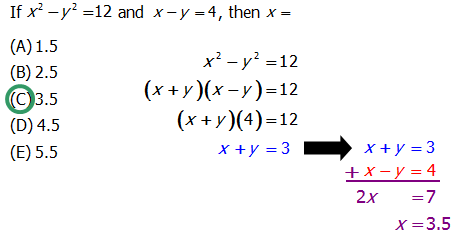
You may remember this formula, one of the sleekest factoring tricks in all of algebra:
This formula, called “the difference of two squares” formula, is a favorite of standardized test writers. A simple enough pattern: see if you can detect where it shows up in the following challenging problems.
Q1.
(A)
(B)
(C)
(D)
(E)
Q2. What is the sum of
Statement 1:
Statement 2:
(A) Statement 1 alone is sufficient but statement 2 alone is not sufficient to answer the question asked.
(B) Statement 2 alone is sufficient but statement 1 alone is not sufficient to answer the question asked.
(C) Both statements 1 and 2 together are sufficient to answer the question but neither statement is sufficient alone.
(D) Each statement alone is sufficient to answer the question.
(E) Statements 1 and 2 are not sufficient to answer the question asked and additional data is needed to answer the statements.
Q3. In the diagram above,
(A)
(B)
(C)
(D)
(E)
Q4. If
(A)
(B)
(C)
(D)
(E)
Q1. This involves a relatively sophisticated trick known as “multiplying by the conjugate.” When we have an expression of the form
This is answer B. BTW, the trick of multiplying by the conjugate is at the very outside edge of what you might be expected to do the hardest QUANT math problems.
Answer = B
Q2. The prompt of this DS problem is straightforward.
Statement #1 tells us
Statement #2 gives us a value for an algebraic expression that lends itself nicely to simplification.
Thus, the sum is
Answer = B
Q3. This is a tricky one. Remember, it’s a diagram drawn to scale, so if all else fails, you can estimate (see this post). But, let’s solve this with math. The fact that
so
Answer = B
Q4.
Answer = C